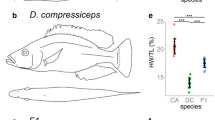Abstract
Skull development after eye migration was studied in a bothid flounder Bothus myriaster (Bothidae). In the stage immediately following the migration, skull ossification was apparently weaker on the blind side than on the ocular side, such being related to the extensive dorsally directed shift of the blind side eye. The blind side frontal had two initial ossification sites; below (“pseudomesial bar” in Psettodes) and behind (“frontal” in bothids) the blind side eye. In bothids, the former was fused with the lateral ethmoid but autogenous to the latter during ontogeny. With increased eye size with growth, the otic region became progressively narrower. The late ossification of the region was considered to provide flexibility for cranial modifications owing to rapid eye enlargement.
Similar content being viewed by others
Author information
Authors and Affiliations
Corresponding author
About this article
Cite this article
Sasaki, K., Yamashita, T. Skull development in a bothid flounder, Bothus myriaster (Pleuronectiformes), with discussion on the homology of the “pseudomesial bar”. Ichthyol Res 50, 326–332 (2003). https://doi.org/10.1007/s10228-003-0175-5
Received:
Accepted:
Issue Date:
DOI: https://doi.org/10.1007/s10228-003-0175-5




